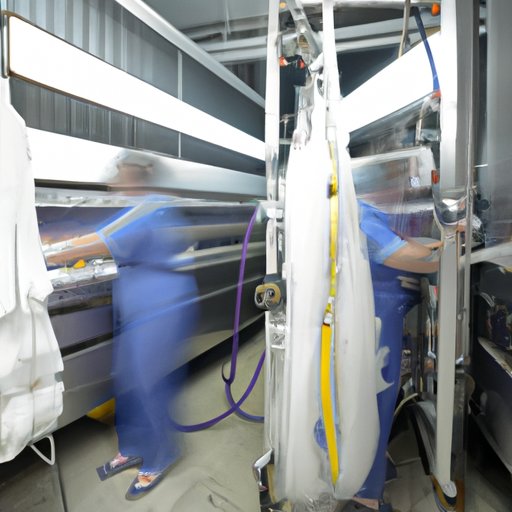Introduction
The dry-cleaning industry is still growing despite its age. According to the U.S. Census Bureau, the average annual revenue for dry cleaners in the United States was estimated at $2.6 billion in 2018. This industry has seen a steady growth over the past few decades due to the increasing demand for quality clothing care services. If you’re considering entering this market, here’s what you need to know about starting a dry cleaning business.

Overview of the Dry Cleaning Industry
The dry cleaning industry is composed of businesses that specialize in cleaning and caring for clothing and other textiles. Dry cleaning is a method of cleaning clothes without using water. Instead, special solvents are used to remove dirt and stains from fabric. This process can be used to clean a variety of fabrics, including wool, silk, and synthetic materials.
Dry cleaning businesses offer a range of services, such as laundry, pressing, and mending. Many dry cleaners also offer additional services, such as alterations, tailoring, and shoe repair. The cost of these services can vary depending on the type of fabric, the size of the item, and the complexity of the work required.

Benefits and Costs of Starting a Dry Cleaning Business
Starting a dry cleaning business can be a great way to make money and provide a valuable service to your community. There are many benefits to owning a dry cleaner, including the potential for high profits and a relatively low cost of entry. However, there are also some costs associated with starting a dry cleaning business, such as leasing or purchasing equipment, hiring staff, and obtaining the necessary licenses.
The amount of money you need to start a dry cleaning business will depend on the type of services you offer and the size of your operation. In general, you should expect to spend several thousand dollars on equipment and supplies. You may also need to pay for rent, advertising, and other expenses. Additionally, you’ll need enough cash to cover your operating costs until you start to see a profit.
Research Licensing Requirements
Before you open your business, you’ll need to research the licensing requirements in your state. Each state has its own regulations regarding dry cleaning businesses, so it’s important to familiarize yourself with the laws in your area. Generally, you’ll need to obtain a business license and any necessary permits before you can open for business.
State and Local Regulations
You’ll need to check with your local government to find out what permits and licenses you need to operate a dry cleaning business in your area. Depending on where you live, you may need to obtain a zoning permit, a fire safety inspection certificate, or a hazardous materials license. Additionally, you may need to register your business with the state or local taxing authority.
Other Requirements
In addition to the licenses and permits mentioned above, you may need to obtain insurance for your business. You may also need to comply with regulations regarding the storage and disposal of hazardous materials. Finally, you should check with your state or local government to see if there are any additional regulations you need to follow.
Identify Target Customer Base
Once you’ve researched the licensing requirements, you’ll need to identify your target customer base. Your target customers should be people who are likely to use your services and have the financial means to do so. To determine who your target customers are, you’ll need to consider the types of clothing they wear, their income level, and their location.
Define Your Ideal Customer
Start by defining your ideal customer. Ask yourself questions such as: What kind of clothing do they wear? What is their income level? Where do they live? Once you’ve identified your ideal customer, you can begin to focus your marketing efforts on reaching them.
Analyze the Competition
It’s also important to analyze the competition in your area. Look at the prices they charge, the services they offer, and the locations they serve. This will give you an idea of how competitive the market is and how you can differentiate yourself from the competition.
Choose Location and Equipment
Once you’ve identified your target customer base and analyzed the competition, you’ll need to choose a location for your business and buy the necessary equipment. The location and equipment you choose will have a big impact on the success of your business, so it’s important to take your time and make the right decisions.
Considerations for Selecting a Location
When selecting a location for your business, consider factors such as visibility, accessibility, parking availability, and competition. You should also consider the size of the space you need and the cost of renting or purchasing the property. It’s important to choose a location that is convenient for your customers and allows you to maximize your profits.
Types of Equipment Needed
In addition to a location, you’ll need to purchase the necessary equipment for your business. You’ll need to buy or lease a dry cleaning machine, presses, steamers, and other equipment. You may also need to purchase supplies such as detergents, hangers, garment bags, and stain removers. The cost of equipment and supplies will vary depending on the size of your business.
Develop an Effective Marketing Plan
Once you’ve chosen a location and purchased the necessary equipment, you’ll need to develop an effective marketing plan. A good marketing plan should include both online and traditional advertising methods. This will help you reach a wider audience and increase your profits.
Online Solutions
Online solutions such as social media, search engine optimization, and email marketing can be effective ways to reach potential customers. You may also want to consider creating a website for your business. A website can provide customers with information about your services, as well as allow them to make reservations or book appointments online.
Traditional Advertising
In addition to online solutions, you’ll want to consider traditional advertising methods such as print ads, radio spots, and television commercials. These methods can be effective for reaching a local audience, but they can be more expensive than online solutions. You may also want to consider offering discounts and promotions to attract new customers.
Establish Pricing Structure
Once you’ve developed a marketing plan, you’ll need to establish a pricing structure for your services. It’s important to set prices that are competitive, but also allow you to make a profit. When setting prices, you should consider factors such as the cost of labor and materials, the cost of renting or purchasing equipment, and the cost of advertising.
Factors to Consider
When determining your prices, you should consider the cost of labor and materials, the cost of renting or purchasing equipment, and the cost of advertising. You should also factor in the cost of overhead, such as rent, utilities, and insurance. Additionally, you should consider the prices of your competitors and the average price for similar services in your area.
Strategies for Setting Prices
There are several strategies for setting prices, such as cost-plus pricing, value-based pricing, and competitive pricing. Cost-plus pricing involves setting prices based on the cost of labor and materials plus a markup. Value-based pricing involves setting prices based on the perceived value of the service. Competitive pricing involves setting prices based on the prices of your competitors.
Create a Business Plan
Finally, you’ll need to create a business plan. A business plan is an essential document that outlines the goals of your business and provides a roadmap for achieving those goals. It should include information such as your mission statement, your target customer base, your pricing structure, and your marketing strategy.
Outline Your Goals
Your business plan should include a list of goals for your business. These goals should be specific, measurable, achievable, relevant, and timely (SMART). For example, one goal could be to increase profits by 10% in the next six months. Another goal could be to double the number of customers within a year.
Financial Considerations
Your business plan should also include financial projections for the first three years of your business. This should include estimates for revenues, expenses, profits, and losses. You should also include a budget for marketing, advertising, and other expenses. Finally, you should outline any sources of financing you may need, such as loans or investments.
Conclusion
Starting a dry cleaning business can be a rewarding experience, but it requires careful planning and preparation. Before you open your business, you’ll need to research the licensing requirements in your area, identify your target customer base, choose a location and equipment, develop an effective marketing plan, establish a pricing structure, and create a business plan. With the right preparation, you can be successful in the dry cleaning industry.
This guide has provided an overview of the steps you need to take to start a dry cleaning business. For more information, you can consult your state or local government, as well as industry experts and professional organizations. With the right knowledge and preparation, you can have a successful dry cleaning business.
(Note: Is this article not meeting your expectations? Do you have knowledge or insights to share? Unlock new opportunities and expand your reach by joining our authors team. Click Registration to join us and share your expertise with our readers.)
